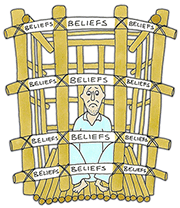
Give your client positivity wellies for their negativity puddle
“I made a total idiot of myself! I was so nervous!”
Peter was extremely distressed, actually hitting himself on the head as he said that. The problem? He’d “completely screwed up” a speech he’d had to give at work and was now sitting in my office, loudly decrying this ‘fact’.
After offering him my sympathies (almost all of us can understand how it feels to screw up a presentation), I asked him, “Did you finish the speech?”
He paused in his hand-wringing. “Yes, I did.”
“So, if you’d run from the room, that would have been even worse than it was?”
Prefer to watch instead?
It’s not the end of the world as we know it
When something in your client’s life goes wrong, it can be very unpleasant. Sometimes they feel as if that means the speech, date, party, day – or even their entire life! – has gone completely wrong.
The trouble is that a habit of ‘globalizing’ one or two things that went a little wrong into a thought like “I made a total idiot of myself” (as Peter did) can lead our clients towards developing depression, chronic anxiety, or other difficulties.
So, as therapists and counsellors, we need to help our clients find ways to turn negatives into positives so they can avoid the pitfalls of larger problems.
Here are 3 questions you can ask to help turn a negative into a positive for your client
1. “How could it have been even worse?”
Peter agreed with me that if he’d run from the room, the speech experience would have been even worse. I asked what else would have made his speech even worse than it was and he soon came up with a long list, including:
- He could have tripped walking up to the podium
- His glass of water might have tipped over and shorted out the projector
- A pen he was fidgeting with might have flown out of his hand and into his manager’s face
- The building could have been destroyed in a sudden earthquake.
…and so on. I encouraged Peter in coming up with ever more imaginative and absurd worse case scenarios and by the end, he was laughing and visibly more relaxed.
Rather than arguing or glibly telling your client it could have been worse (how annoying is that?), this question allows you to start gently examining together what really did happen without denying that their experience felt like a complete failure to them at the time.
And as Peter started to understand on his own that his speech had gone better than he’d initially thought, he remembered that some people had said his speech was pretty good, although his manager told him he needs to relax more in future when he’s presenting.
So I asked him…
2. “What did you do to stop it being even worse?”
“How did you manage not to run from the room, given that you were so nervous?”
“I knew that my team were depending on this presentation, because it’s going to affect our budgets for future projects for a long time. So I knew I just had to get on with it.”
We need to find out how someone isn’t in their worst case scenario. Asking what they did or are doing to make this possible returns a sense of control and is a nifty way of locating and building their resources for future therapeutic use.
“So,” I said, “in a way, you made a courageous speech.” When Peter nodded, I continued, “Basic courage is a pretty good starting point to overcoming excess fear and becoming a relaxed superstar of a public speaker one day, is it not?”
“One day… I hope!” he said, sounding a little excited at the idea.
However, if your client says that a change in circumstances is what made the difference, rather than their efforts, this is still vital information. You can then ask, “What do those changed circumstances tell you about what more you need in life to start doing (or feeling) better?”
And how will they know if they’re better or worse?
3. “On a scale from 1 to 10, how bad is it really?”
Nothing is infinite and eternal (except perhaps the universe and presidential election campaigns – although I’m not sure about the universe).
There are always degrees of experience. And ‘scaling‘ is an effective tool you can teach your client for bringing together the first two questions to start:
- Breaking down unhelpful globalized, ‘all or nothing’ thinking.
- Figuring out what steps they can take to work towards improvement and solutions.
For example, I suggested to Taylor, a client suffering from depression, that ’10’ was “the happiest you can possibly be, so happy that it annoys your neighbours,” and ‘1’ was “the most depressed you can possibly be.” Then I asked where she was on that scale at the moment. She replied she was at ‘3’.
“Okay, so how come you are not at ‘2’?”
This seems like a negative question, but you’re getting your client to think about what they’re doing that’s constructive – or at least starting to gently lead them in the direction of that positive focus.
“I suppose,” Taylor said, “it’s because I ate lunch in the park today instead of at my desk. The sun was out, which felt nice, and I enjoyed watching two squirrels chasing each other around…”
Taylor and I also talked about times in the past when she’d been at ‘4’ (or even much higher). When I inquired what her life had given her on one of those days that might be missing now, she said, “One day, my friend Sue called just to ask how I was doing and really listened to my reply. It helped to know I have someone who cares.”
Scaling can give us both fuel and content to form therapeutic goals. For Taylor, it became clear that things like time outside, her love of animals, and social contact with close friends were important for her wellbeing. So together we were able to form specific, measurable goals towards making those things more a part of her life.
Other questions that can help you and your client form small achievable goals include:
- How will you know when you have risen to ‘7’?
- What will you be doing differently at ‘5’? (The ‘doing’ word is very important because goals need to be measurable.)
A lot of stuff that goes really badly doesn’t go completely badly. Learning to know the difference, as well as what can start to turn a negative into a positive and make things just a bit better, can start the ball rolling towards greater wellbeing and help prevent a lot of unneeded suffering.
Would you like to enhance your reframing skills?
Click here to read how my online course ‘Conversational Reframing’ shows you how to craft cunning reframes and slip them past your clients’ conscious criticisms.






